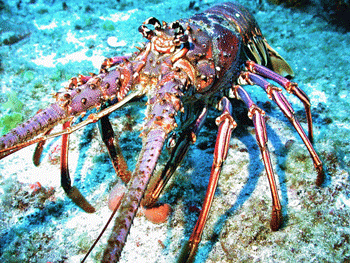Colorful Caribbean Spiny Lobsters
Where Caribbean Spiny lobsters live
Caribbean spiny lobsters are found in tropical and subtropical waters. They are also known as Florida spiny lobsters. Adults live in cracks and crevices of coral reefs, sponge flats and other hard-bottom areas. Spiny lobsters unlike other forms of lobsters caught along the Atlantic Coast they lack large claws. The adult lobster’s exoskeleton varies in color from light red and deep brown.

Colorful spiny lobster on the seafloor, NOAA
Atlantic coast spiny lobsters
Spiny lobsters live along the Atlantic Coast all the way from North Carolina south to Brazil. They are found in subtropical and tropical waters especially off the coast of Florida and the Caribbean Sea. They are warm water lobsters since they live in the sub-tropical to tropical regions. Other lobsters living north or south of sub-tropical areas are cold water lobsters.
Where they live and what they eat
Caribbean spiny lobsters spend their days in crevices and caverns of coral reefs hiding from predators except for males when they are looking for a mate during mating season. As the sun goes down lobsters come out of their homes to look for food. They spend their nights feeding on small snails, clams, chitons and crabs. They also eat dead and decaying organisms.
Predators of spiny lobsters
Caribbean Spiny Lobsters are a favorite food of sharks, rays, groupers, triggerfish, moray eels, sea turtles and octopus. They are also a favorite food of humans. In the Caribbean and other places around the world they are a major source of income for commercial fishermen. If you have ever eaten lobster tails you were probably eating the tail of a spiny lobster.

Our Fun Science Oceans ebook is 140 pages of fascinating information about the oceans. Chapters in the book include Zones of Life, Tsunamis, and Fantastic Fish. Myrna Martin

Click for More Information and to Order
How they got their name spiny lobsters
Spiny lobsters get their name for the small spikes covers their carapace (exoskeleton). Males and females are the same size but the male’s exoskeleton is longer. Adult Caribbean Spiny Lobsters have two long antennae that are longer than their carapace. Small antennae that are shorter and about two-thirds of their body length. Two large eyes are at the front of their heads, pleopods which are forked legs that aid them when swimming. Spiny lobsters have small claws unlike Maine lobsters which have large claws.
Reproduction of spiny lobsters
Spiny lobsters mate from March through June or June through November depending on where they live. The male Caribbean Spiny Lobster comes out during the day and seek out a female that he coaxes out of her home. They mate belly to belly with the male depositing a sac (spermatophore) on the underside of her tail or belly.
The female carries the sac around until her eggs are ready to be fertilized. She breaks open the sac to fertilize her eggs. Depending on the size of a female lobster she may produce 230,000 to 2.6 million eggs. She carries all of her eggs beneath her tail for about a month until they are ready to hatch into larvae.
Spiny lobster Larvae
Larvae can be carried thousands of miles before they settle into seagrass or algae beds to grow. Baby lobsters live a solitary existence until they begin to congregate and migrate to offshore reefs where they mature. Lobsters continue to grow their entire life and molt when they outgrow their exoskeleton. During molting the lobsters are vulnerable to a number of predators. It usually takes several days for them to regrow an exoskeleton.
spiny lobsters migrate each year
Spiny lobsters are capable of true migration using the Earth’s magnetic field. They usually begin to migrate after the first major storm in the fall to offshore areas. They form a long single line of up to 50 individuals that march away from shallow waters. They migrate to areas where the water temperature is more stable.
KIDS FUN Science Bookstore
Check out Myrna Martin's award winning textbooks, e-books, videos and rock sets. The Kids Fun Science Bookstore covers a wide range of earth science topics. Click here to browse.










